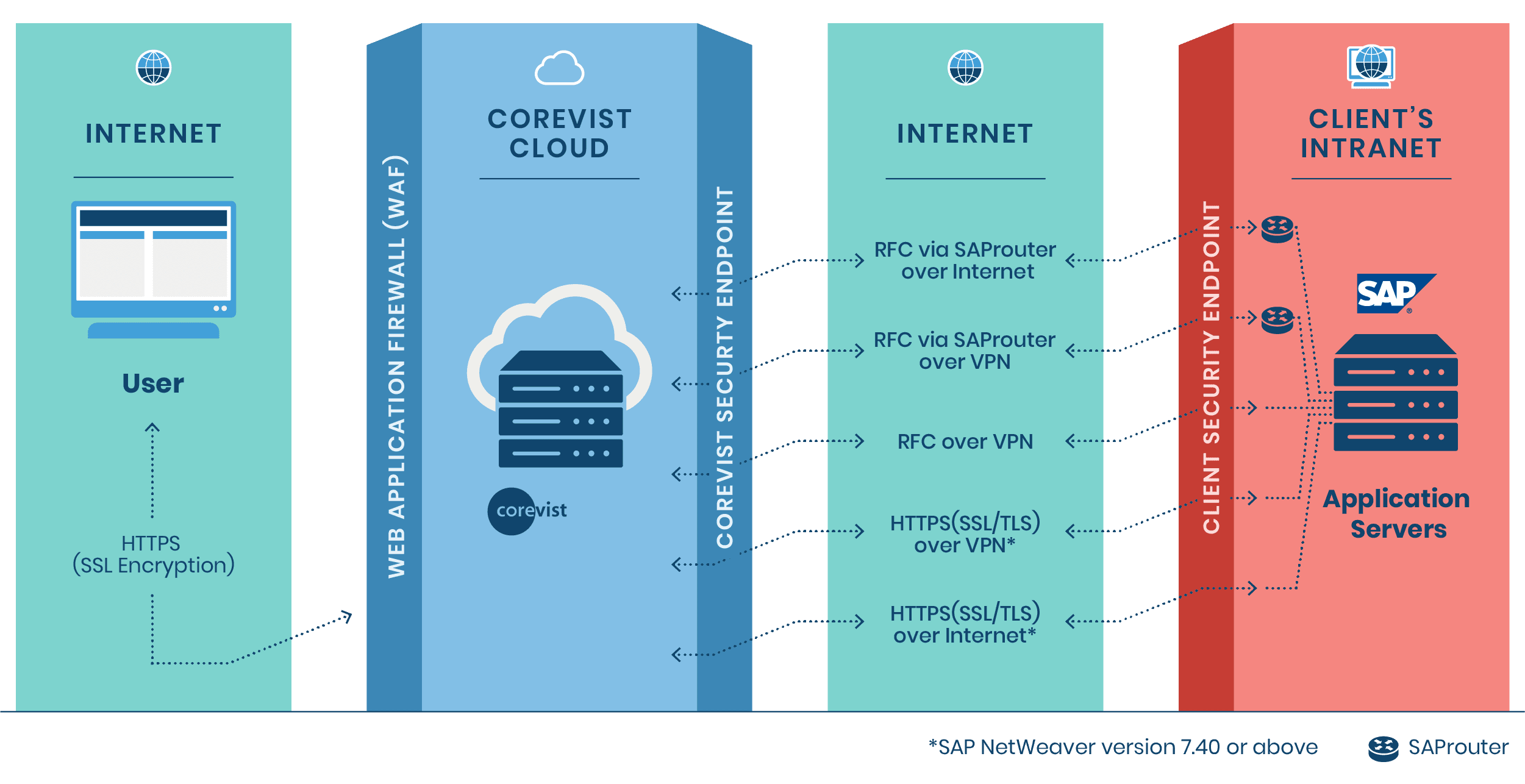Share
Author
Tomas Maza
Share
A great user experience is key to a successful web channel. For manufacturers, real-time SAP integration is the bedrock on which a great user experience is built. That’s why Corevist Commerce Cloud includes our prebuilt, configurable integration that plugs right into your ERP system.
But how does Corevist actually talk to SAP? And what options exist for connecting to your SAP system?
The short answer is—Corevist communicates with SAP via HTTPS or RFC, whichever you prefer.
Here are the details (and what they mean for your customers and internal users).
Context: How Corevist’s SAP integration creates user experiences
Say a customer logs in to your Corevist web portal and requests a list of sales orders. When they click the button to view the list, our web application calls the Corevist ABAP function module installed in your SAP system (one of our APIs) that pulls a list of sales orders. Our application passes the user-specified parameters as part of the request—e.g. the date range, sold-to, and so on.
Our ABAP function module pulls that SAP data and returns the response to the web application, providing the requested list of sales orders in real time.
This is what we mean when we say “calling SAP” or “talking to SAP.” Our web application calls our proprietary APIs which we’ve installed in your SAP system.
So how does Corevist Commerce Cloud actually talk to SAP in real time?
Glad you asked. 😊
Options for real-time interaction with SAP ERP
At a high level, there are only two ways for an outside system to interact with SAP in real time:
- RFC (remote function call). This option speaks the language of SAP’s proprietary protocol. This protocol is not encrypted, so it requires either a VPN IPSec (more common) or SNC tunnel (less common) for security.
- Web services. The option speaks the language of the internet. It uses an HTTPS connection, which means it’s secure by nature and doesn’t strictly require a VPN tunnel for security, although you may decide to deploy one for an additional layer of security.
Corevist Commerce Cloud can use either method in several different configurations:

So which is best, HTTPS or RFC?
The answer depends on your organization’s needs, your SAP system, and what technologies & protocols your IT team prefers to use. Though HTTPS may offer a slight speed increase, there is essentially no difference in the user experience. The benefits of one protocol over the other are largely internal to your organization.
Benefits of HTTPS:
- Secure by default with no “strict” VPN requirement. Not every organization wants to use a VPN (IPSec) tunnel to connect with their SAP ERP system. Although you’ll see the option “RFC via SAProuter over internet” in the diagram (i.e. sending RFCs outside of a VPN), this method requires taking additional security measures. RFCs sent outside a VPN tunnel must be secured enabling SNC (Secure Network Communications) in the SAProuter. Talking to SAP via HTTPS allows you to bypass the VPN requirement with a connection method that’s inherently secure.
- Potential speed boost. While response times vary based on the inherent response time of your SAP system, a web services integration (HTTPS) may perform better than RFCs.
Benefits of RFC:
- Familiar protocol for SAP teams. Since RFCs are SAP’s traditional, proprietary method of accessing the ERP system remotely, your IT team may be more comfortable working with this method.
What does this mean for Corevist solutions?
Corevist’s solutions are certified on SAP NetWeaver. Since NetWeaver 7.40 and above fully support HTTPS, you can use either method (RFCs or HTTPS) to connect to SAP.
Whether you choose RFCs or HTTPS, Corevist Commerce Cloud offers direct, real-time integration to SAP ERP. In either scenario, your solution will still leverage Corevist’s comprehensive integration to SAP (which includes 49 integration points and 426 ABAP objects).
This comprehensive integration gives your customers (and/or internal users) the personalized experience they need in your web portal. It means you don’t have to rebuild, synchronize, or maintain SAP data and business rules in another system. You can maintain one system of record (SAP). Your Corevist solution will automatically reflect the relevant data and enforce the relevant business rules.
Want to become Easier To Do Business With?
Check out Corevist Commerce Cloud.
Managed B2B portals and eCommerce with prebuilt integration for ECC and S/4HANA.










